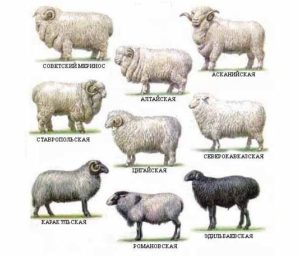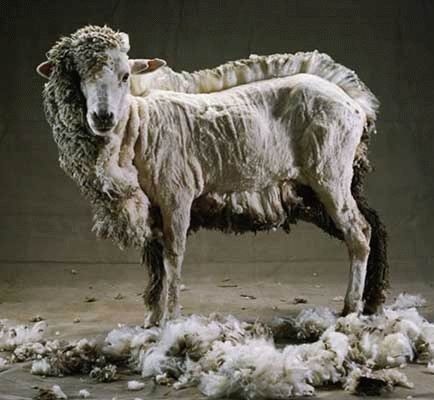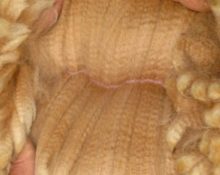Despite the fact that sheep are animals that are popular among farmers, it is necessary to choose a breed for specific purposes. Not all species are suitable for producing large milk or meat yields. Merinos are the breed of sheep with which you can get the maximum amount of wool.
Merino breed - description
Merino sheep look smaller in appearance than their meat breed sisters. Sheep wool is distinguished by its quality, durability and at the same time fine fibers.
Good to know! From one sheep you can shear as much as is removed from three of its competitors, intended for growing meat.
Origin of sheep
 The homeland of merino sheep is Spain. From the 12th to the 18th centuries, the country had a monopoly and tried not to spread the breed to other continents. The export of sheep was punishable by law and considered a crime. Smugglers caught for transportation lost their lives. However, despite the prohibitions, sheep gradually began to live in Europe, Asia, America and Australia. To a lesser extent, Merinos live in hot latitudes.Animals are adversely affected by high temperature and humidity. It is logical to assume that with such a thick coat of wool, sheep of this breed are uncomfortable in the heat.
The homeland of merino sheep is Spain. From the 12th to the 18th centuries, the country had a monopoly and tried not to spread the breed to other continents. The export of sheep was punishable by law and considered a crime. Smugglers caught for transportation lost their lives. However, despite the prohibitions, sheep gradually began to live in Europe, Asia, America and Australia. To a lesser extent, Merinos live in hot latitudes.Animals are adversely affected by high temperature and humidity. It is logical to assume that with such a thick coat of wool, sheep of this breed are uncomfortable in the heat.
External differences between merino and other types
The muzzle is elongated, there are branched horns on the head. The legs are well developed, which allows them to travel long distances in search of food. To distinguish Merino from another breed, you should pay attention to the skin. Sheep of this breed have beautiful hair. The wool is thin and pleasant to the touch.
Merino sheep wool, its properties
Animals are specially raised for wool. The fibers are soft and clean. They absorb moisture and do not retain foreign odors. Items made from merino wool are popular and considered very practical.
Merino care
 It is recommended to walk sheep daily and bathe them periodically. The spree should be warm, with normal temperature conditions. Drafts and hypothermia of individuals should not be allowed.
It is recommended to walk sheep daily and bathe them periodically. The spree should be warm, with normal temperature conditions. Drafts and hypothermia of individuals should not be allowed.
Hooves
The weak point of Merino sheep is their hooves. If they are not trimmed in time, soil, grass remains, or other food will begin to get clogged under the nails. The nail curls up and grows into the skin, which causes pain and discomfort. It is necessary to cut with pruning shears. To do this, the animal is laid on its side, the leg is fixed and the nail is cut off. It is advisable to carry out the procedure together, starting from the age of one month.
Nutrition
The diet should include:
- fresh grass or hay;
- cereals (oats, barley, bran);
- vegetables;
- salt and vitamins.
To obtain meat, it is best to keep animals in a well-equipped pen and not take them out into the field. The search for food does not give the desired results, and the individuals do not gain weight.
Reproduction
The sheep becomes ready for mating at one year of age.It is desirable that the offspring appear in the spring. The gestation period is about five months.
Raising lambs
The young offspring must be fed with mother's milk for at least a month. After two weeks, babies need to be introduced to additional food. This should be done gradually so that the stomach gets used to new foods. For the first feeding, young grass, mixed feed and cereals (barley or oats) are suitable.
Merino breeds
 Endurance, ease of care and high productivity have forced many breeders to develop breeds that could combine not only high performance in wool production. Scientists wanted to add the production of meat and milk to the general list, while preserving the original uniqueness of the animal. As a result, several of the most popular breeds were developed.
Endurance, ease of care and high productivity have forced many breeders to develop breeds that could combine not only high performance in wool production. Scientists wanted to add the production of meat and milk to the general list, while preserving the original uniqueness of the animal. As a result, several of the most popular breeds were developed.
Soviet
The adult is a large ram with a thick coat of curly hair and a brown coloration. Obtained by crossing Ramboulier (a breed of sheep originally from France) and Caucasian sheep. They have obvious differences:
- horns curved to the side and sharp at the end;
- fold on the neck;
- males weigh about 100 kg;
- high fertility;
- per year, about 15 kg of wool is sheared from a ram, from females - 2 times less;
- strong legs covered with hair.
The breed is valued for its unpretentiousness. They make a good profit from the animals, and investments in the business quickly pay off. At the moment, this is the most popular Merino breed. It is most widespread in the Caucasus, Altai and Stavropol region.
French
Another name for merino is ramboulier. The ancestors of sheep come from England and Spain. Like the Soviet representatives, French sheep and rams have high rates of wool and meat, but are slightly inferior to them. Main characteristics of the breed:
- weight is slightly less than that of Soviet Merinos (90 kg for males, about 60 for females);
- 10 kg of wool per year is obtained from rams, half as much from sheep.
Ramboulier is often used to develop new breeds. Long and thick wool, adaptability to external factors and high productivity are valued by breeders and livestock breeders.
Australian
The breed was developed by crossing American and French sheep. There are three subspecies of these animals, which differ in the amount of wool sheared per year and size.
- Fine has the lowest rates (no more than 70 kg of meat and 5 kg of beige wool).
- Medium has a white coat. About 40 to 80 kg of meat and 8 kg of wool fibers are obtained.
- Strong is the largest subspecies. The weight reaches 90 kg, the weight of cut wool is 10 kg.
Askaniyskaya
Animals come from Ukraine. They combine high meat and wool characteristics. They are not inferior in weight and wool to the Soviet representatives of merino sheep.
Spanish
It is distinguished by fine wool and whimsicality. Does not tolerate temperature changes or heat.
Sheep shearing process. What you need for work, how to handle animals
Before the procedure, the animal should not be fed for 24 hours. Haircuts must be carried out from the age of one in the spring. Winter offspring are sheared at the end of summer.

For cutting, you should choose a dry place; the wool should also not be wet or damp to the touch. Usually two or three people cut their hair. One person holds the animal, and the other carefully trims the fleece. The procedure is carried out immediately, without delaying cutting other areas indefinitely.
After three weeks, the animal must be bathed. This can be done in a pond or on a site using a hose. The water pressure should not harm the animal.


 0
0





